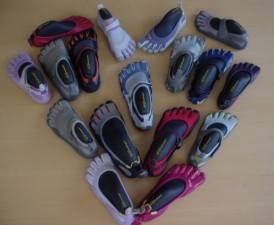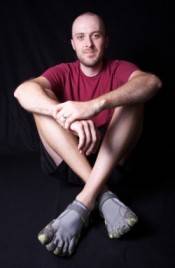 Some of you may have seen them around town, those funky toed shoes some runners wear. You know what I’m talking about; the runners look like they have webbed feet. Everybody stares at them. The people wearing them are usually running on grass, and they have a slightly unusual gait, like they’re running gingerly, afraid they will trip and stub their toes. You might expect that when people are (basically) running shoeless through Champaign-Urbana.
Some of you may have seen them around town, those funky toed shoes some runners wear. You know what I’m talking about; the runners look like they have webbed feet. Everybody stares at them. The people wearing them are usually running on grass, and they have a slightly unusual gait, like they’re running gingerly, afraid they will trip and stub their toes. You might expect that when people are (basically) running shoeless through Champaign-Urbana.
Those who use the Vibram Five Fingers swear by them. It’s a kind of subculture in the running community, much like ultra marathoners — where 26.2 miles just isn’t enough. In this case, they want to “feel” the ground underneath them.
I talked to some local runners, and here’s what they had to say about the Vibram.
Why do you wear them?
 Rob Raguet-Schofield (pictured on the right) is a local runner and cyclist who is a software developer at Wolfram. He is moving to St. Louis.
Rob Raguet-Schofield (pictured on the right) is a local runner and cyclist who is a software developer at Wolfram. He is moving to St. Louis.
I really like the feel of my feet on bare grass and dirt in these shoes. It’s hard to describe. It’s almost like a massaging feeling. They provide an interesting sensation on pavement as well, but dealing with that takes some built-up tolerance. At first it just hurts to run on pavement in these shoes.
Jason Elliot is a local runner who is a Ph.D. candidate in mathematics at the University of Illinois.
I prefer to go barefoot. Five fingers are the next best thing for when I need shoes. Going barefoot strengthens the feet by actively engaging the muscles in the feet and lower legs. It also stretches the calves and hamstrings because the heel is not being raised relative to the forefoot. As a result, one develops a better posture and a stronger core. I wear either the five fingers or a pair of hurraches when go somewhere that requires shoes (eg. a restaurant) or when I feel like I need a little protection, like a long run or a run where I’m likely to meet sharp pokey things.
How long have you worn them?
Rob: A little over a year, though I didn’t wear them much over the winter. I discovered around 38˚ F was as cold as I could stand to wear them. It took a few months to build up to higher mileages, but I’ve run 15 miles on trails or 10 miles on pavement wearing these shoes with no problems.
Jason: I bought my first pair about 2 years ago.
What made you start wearing them?
Rob: I started wearing them a bit out of desperation. I suffered from a string of one running-related injury after another (usually my knees), and I was at the point where I was willing to try anything different. A few years prior I had tried running barefoot on grass every once in a while, but the bottoms of my feet were a bit too tender for that. I saw these shoes on the internet a couple years ago, and I thought they might be good to try. They were a little more expensive than I would have expected, so I didn’t want to order them without trying them on first to get the proper fit and see if I liked them. Last summer I heard from a friend that Champaign Surplus was carrying them, so I rushed over to try them out. I bought a pair, and I’ve been wearing them ever since.
Jason: I was looking for something that was very close to being barefoot, but provided a little protection from things like sharp rocks and broken glass.
Has your running improved since you’ve been wearing them? If so, how?
Rob: Yes and no, it’s a mixed bag. I can definitely feel that my form has improved in certain ways. I run more on the balls of my feet than I did previously (I can really feel the difference in my calf muscles, which were underused before). I am also able to enjoy feeling the ground with my feet as I run now. That said, they’re not without their drawbacks. First, you have to build up your mileage slowly. You can’t (or at least you shouldn’t) jump from running 6–8 miles in running shoes to running 6–8 miles in Five Fingers. Start with a mile on grass, then two, then start by walking on pavement, then move to running a short distance on pavement, etc. Next, when they get really wet (saturated) they tend to slide around a lot and rub your feet raw in places. So I don’t wear them in the rain, mud, and I even have problems in extreme heat (I’m a heavy sweater). Finally, I had one fairly unpleasant incident last November when halfway through a 21 mile trail run I stepped on a thorn that went through the thin shoe and into my foot. It took several painful minutes to dislodge it. But it wasn’t too bad because I finished the run, though I switched to heaver shoes for the last few miles.
Jason: Definitely. It has improved in exactly the ways I described above, i.e., more strength in my lower legs and better posture.
Do people stare at your feet a lot when you wear the five fingers shoes? How do you deal with that?
Rob: Yes, everyone stares. A woman in a San Francisco restaurant even insisted on touching them. It’s a bit weird. I don’t have a good strategy for dealing with it; I usually just smile awkwardly.
Jason: Yes. I usually try to be patient and explain to them (if they ask) the purpose behind them, i.e., being close to being barefoot.
Do you have anything else you’d like to add about running in the Five Fingers shoes?
Rob: I think it’s definitely worth it for many people to give them a try, though it would be nice if they were a little less expensive. The most important piece of advice I could give people would be to take your time and build up your distance in these shoes slowly. I ran in these shoes for a good five months before I attempted a six mile run on pavement in them.
Jason: Anyone considering barefoot running should transition slowly. Being barefoot is very natural and what your body was designed to do, but most of us have been wearing modern shoes for most of our lives. As a result, the muscles in the feet have atrophied, the calves and hamstrings have shortened, and gait has changed. It takes time to strengthen the muscles and adapt to being barefoot. Trying to transition too quickly can result in injury.
Finally, I spoke with Marla Luckey, a former Champaign-Urbana resident and current graduate student at the University of Michigan. She has owned the Vibram for years but has just recently run in them. She told me about her experience wearing the Vibram when she was in Ecuador: “I definitely get a lot of looks and comments!” she said. “Actually, while at a market in Ecuador this summer, an indigenous woman bent down and was pulling on my toes while her husband was talking to me!”
Running in Vibram Five Fingers is not for everyone, but you’ll certainly be the talk of the town if you do.








